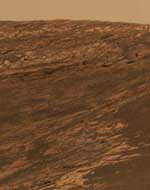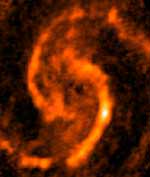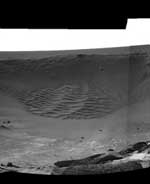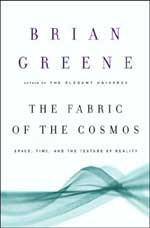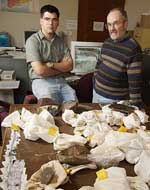
Image credit: Stanford
If a time machine could take us back 4.6 billion years to the Earth’s birth, we’d see our sun shining 20 to 25 percent less brightly than today. Without an earthly greenhouse to trap the sun’s energy and warm the atmosphere, our world would be a spinning ball of ice. Life may never have evolved.
But life did evolve, so greenhouse gases must have been around to warm the Earth. Evidence from the geologic record indicates an abundance of the greenhouse gas carbon dioxide. Methane probably was present as well, but that greenhouse gas doesn’t leave enough of a geologic footprint to detect with certainty. Molecular oxygen wasn’t around, indicate rocks from the era, which contain iron carbonate instead of iron oxide. Stone fingerprints of flowing streams, liquid oceans and minerals formed from evaporation confirm that 3 billion years ago, Earth was warm enough for liquid water.
Now, the geologic record revealed in some of Earth’s oldest rocks is telling a surprising tale of collapse of that greenhouse — and its subsequent regeneration. But even more surprising, say the Stanford scientists who report these findings in the May 25 issue of the journal Geology, is the critical role that rocks played in the evolution of the early atmosphere.
“This is really the first time we’ve tried to put together a picture of how the early atmosphere, early climate and early continental evolution went hand in hand,” said Donald R. Lowe, a professor of geological and environmental science who wrote the paper with Michael M. Tice, a graduate student investigating early life. NASA’s Exobiology Program funded their work. “In the geologic past, climate and atmosphere were really profoundly influenced by development of continents.”
The record in the rocks
To piece together geologic clues about what the early atmosphere was like and how it evolved, Lowe, a field geologist, has spent virtually every summer since 1977 in South Africa or Western Australia collecting rocks that are, literally, older than the hills. Some of the Earth’s oldest rocks, they are about 3.2 to 3.5 billion years old.
“The further back you go, generally, the harder it is to find a faithful record, rocks that haven’t been twisted and squeezed and metamorphosed and otherwise altered,” Lowe says. “We’re looking back just about as far as the sedimentary record goes.”
After measuring and mapping rocks, Lowe brings samples back to Stanford to cut into sections so thin that their features can be revealed under a microscope. Collaborators participate in geochemical and isotopic analyses and computer modeling that further reveal the rocks’ histories.
The geologic record tells a story in which continents removed the greenhouse gas carbon dioxide from an early atmosphere that may have been as hot as 70 degrees Celsius (158 F). At this time the Earth was mostly ocean. It was too hot to have any polar ice caps. Lowe hypothesizes that rain combined with atmospheric carbon dioxide to make carbonic acid, which weathered jutting mountains of newly formed continental crust. Carbonic acid dissociated to form hydrogen ions, which found their way into the structures of weathering minerals, and bicarbonate, which was carried down rivers and streams to be deposited as limestone and other minerals in ocean sediments.
Over time, great slabs of oceanic crust were pulled down, or subducted, into the Earth’s mantle. The carbon that was locked into this crust was essentially lost, tied up for the 60 million years or so that it took the minerals to get recycled back to the surface or outgassed through volcanoes.
The hot early atmosphere probably contained methane too, Lowe says. As carbon dioxide levels fell due to weathering, at some point, levels of carbon dioxide and methane became about equal, he conjectures. This caused the methane to aerosolize into fine particles, creating a haze akin to that which today is present in the atmosphere of Saturn’s moon Titan. This “Titan Effect” occurred on Earth 2.7 to 2.8 billion years ago.
The Titan Effect removed methane from the atmosphere and the haze filtered out light; both caused further cooling, perhaps a temperature drop of 40 to 50 degrees Celsius. Eventually, about 3 billion years ago, the greenhouse just collapsed, Lowe and Tice theorize, and the Earth’s first glaciation may have occurred 2.9 billion years ago.
The rise after the fall
Here the rocks reveal an odd twist in the story — eventual regeneration of the greenhouse. Recall that 3 billion years ago, Earth was essentially Waterworld. There weren’t any plants or animals to affect the atmosphere. Even algae hadn’t evolved yet. Primitive photosynthetic microbes were around and may have played a role in the generation of methane and minor usage of carbon dioxide.
As long as rapid continental weathering continued, carbonate was deposited on the oceanic crust and subducted into what Lowe calls “a big storage facility … that kept most of the carbon dioxide out of the atmosphere.”
But as carbon dioxide was removed from the atmosphere and incorporated into rock, weathering slowed down — there was less carbonic acid to erode mountains and the mountains were becoming lower. But volcanoes were still spewing into the atmosphere large amounts of carbon from recycled oceanic crust.
“So eventually the carbon dioxide level climbs again,” Lowe says. “It may never return to its full glorious 70 degrees Centigrade level, but it probably climbed to make the Earth warm again.”
This summer, Lowe and Tice will collect samples that will allow them to determine the temperature of this time interval, about 2.6 to 2.7 billion years ago, to get a better idea of how hot Earth got.
New continents formed and weathered, again taking carbon dioxide out of the atmosphere. About 3 billion years ago, maybe 10 or 15 percent of the Earth’s present area in continental crust had formed. By 2.5 billion years ago, an enormous amount of new continental crust had formed — about 50 to 60 percent of the present area of continental crust. During this second cycle, weathering of the larger amount of rock caused even greater atmospheric cooling, spurring a profound glaciation about 2.3 to 2.4 billion years ago.
Over the past few million years we have been oscillating back and forth between glacial and interglacial epochs, Lowe says. We are in an interglacial period right now. It’s a transition — and scientists are still trying to understand the magnitude of global climate change caused by humans in recent history compared to that caused by natural processes over the ages.
“We’re disturbing the system at rates that greatly exceed those that have characterized climatic changes in the past,” Lowe said. “Nonetheless, virtually all of the experiments, virtually all of the variations and all of the climate changes that we’re trying to understand today have happened before. Nature’s done most of these experiments already. If we can analyze ancient climates, atmospheric compositions and the interplay among the crust, atmosphere, life and climate in the geologic past, we can take some first steps at understanding what is happening today and likely to happen tomorrow.”
Original Source: Stanford News Release

